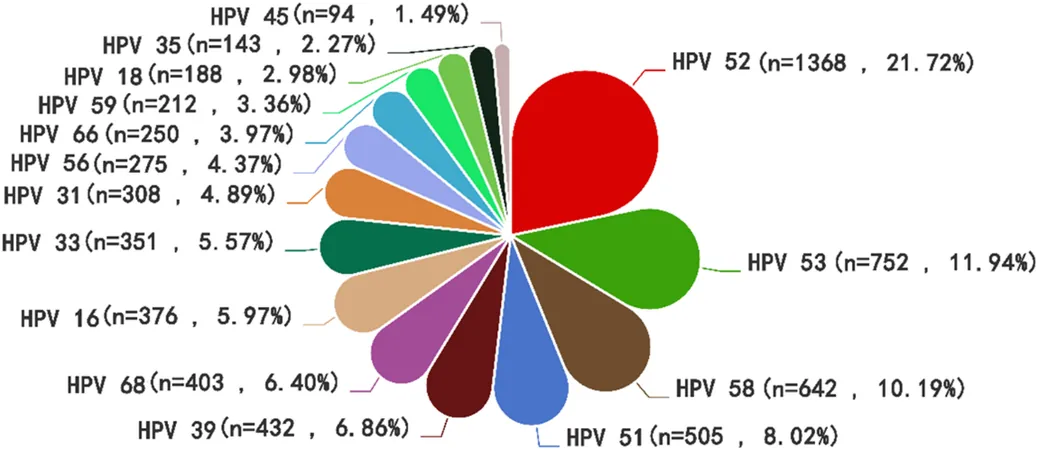
Striking HPV Trends Revealed in Shanghai: What You Need to Know!
2025-07-07
Author: Wei Ling
Major Findings on HPV in Shanghai's Yangpu District
A groundbreaking study covering 2020 to 2024 has unveiled concerning trends about human papillomavirus (HPV) infections in Yangpu District, Shanghai. Out of a staggering 19,142 clinical samples tested, 4,421 were found positive for HPV. Overall, this results in an alarming positivity rate of 23.10%. In particular, outpatient visits showed a higher rate of 25.41%, compared to 16.65% in inpatients and just 10.48% in those undergoing routine check-ups. This variation highlights a significant public health concern, emphasizing the importance of targeted screening in symptomatic individuals.
The Downward Spiral of HPV Positivity Rates
Between 2020 and 2024, researchers noted a notable decline in annual HPV positivity rates, showcasing an overall downward trend that could indicate improved awareness or preventive measures. However, comparisons within years revealed significant fluctuations, especially between 2021 and 2024.
Diverse Subtype Distribution: What Does It Mean?
Among the identified HPV subtypes, all 15 were detected. The dominating trio, HPV-52, HPV-53, and HPV-58, accounted for a staggering percentage of infections—21.72%, 11.94%, and 10.19% respectively. In contrast, HPV-45 showed just a 1.49% detection rate. This variety emphasizes the urgent need for more comprehensive vaccination coverage.
Age Groups Under the Microscope: Key Insights
Participants were divided into various age brackets, revealing the highest HPV rates in younger populations aged 20 and below, reaching a shocking 57.69%. Interestingly, the 61 to 70 age group also showed significant rates, hinting at a dual-peak age distribution notable for HPV infections. As the study emphasizes, age-specific screening could be crucial for effective prevention.
Mixing It Up: The Reality of Co-Infections
The research also uncovered an intriguing trend in HPV infections: 28.07% of HPV-positive cases involved multiple strains. Notably, one individual was found co-infected with nine different subtypes, showcasing the complexity of HPV transmission and raising concerns about the heightened risks of cervical cancer associated with such mixed infections.
The Role of Vaccination: An Urgent Call to Action
Since the initiation of HPV vaccination in Shanghai in 2017, with the nine-valent vaccine introduced in 2018, awareness has grown. Sadly, participation remains low, primarily due to cost and accessibility issues. With only the nine-valent vaccine effective against prevalent strains like HPV-52 and HPV-58, healthcare officials are urged to step up efforts in education and outreach.
Conclusions and Future Directions
This extensive investigation into cervical cancer epidemiology in Shanghai's Yangpu District underlines urgent public health implications. With a striking HPV prevalence and significant geographical discrepancies in fringe areas, the study signals a clarion call for enhanced vaccination strategies and broader screening programs. Future research should aim for larger, multi-center cohorts to further unravel the association between HPV infections and cervical lesions.
Why It Matters: A Public Health Perspective
The implications of this study stretch far beyond Shanghai, as it contributes to the larger conversation on HPV awareness and prevention in China and potentially worldwide. As HPV remains a leading cause of cervical cancer, understanding its spread and impact is crucial in crafting effective public health policies aimed at reducing infection rates and preventing cancer.


 Brasil (PT)
Brasil (PT)
 Canada (EN)
Canada (EN)
 Chile (ES)
Chile (ES)
 Česko (CS)
Česko (CS)
 대한민국 (KO)
대한민국 (KO)
 España (ES)
España (ES)
 France (FR)
France (FR)
 Hong Kong (EN)
Hong Kong (EN)
 Italia (IT)
Italia (IT)
 日本 (JA)
日本 (JA)
 Magyarország (HU)
Magyarország (HU)
 Norge (NO)
Norge (NO)
 Polska (PL)
Polska (PL)
 Schweiz (DE)
Schweiz (DE)
 Singapore (EN)
Singapore (EN)
 Sverige (SV)
Sverige (SV)
 Suomi (FI)
Suomi (FI)
 Türkiye (TR)
Türkiye (TR)
 الإمارات العربية المتحدة (AR)
الإمارات العربية المتحدة (AR)